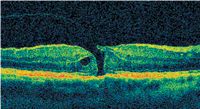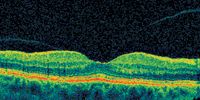Article
Stage 0 macular holes: a new stage in classification
The investigators concluded that the original appearance described as mild was actually protective against the formation of macular holes.

This appearance carries a 6-fold increase in the risk of macular hole formation, said Jay S. Duker, MD, professor and chairman, New England Eye Center, Tufts-New England Medical Center, Tufts University School of Medicine, Boston.


Six months later, the patient returned with a sudden decrease in visual acuity in the left eye to 20/80. The fluorescein angiogram was not helpful, according to Dr. Duker. The patient at this time had a small stage 2 eccentric macular hole in the left eye. The patient underwent surgery and the visual outcome was good.
"The question that arose for us was whether this OCT appearance was significant and can it answer the question about whether an eye is at risk for bilaterality in macular hole disease," he said.
Dr. Duker and colleague Annie Chan, a fourth-year medical student at Tufts University School of Medicine, conducted a retrospective study of patients who had undergone OCT with the prototype OCT at the New England Eye Center between 1994 and 2000. The charts of patients who had a full-thickness macular hole in one eye and a clinically normal fellow eye were reviewed. Patients were excluded if they presented with bilateral macular holes evident on the clinical examination or on OCT or if they had a posterior vitreous detachment in the contralateral eye.
Ninety-four patients, about two-thirds of whom were women, met the inclusion criteria. The follow-up ranged from slightly less than 2 months to 142 months.
The investigators examined all the linear OCT images from the contralateral eyes and, he explained, they rated the vitreous signals as normal, mild, moderate, or severe in appearance. The normal appearance had no abnormal vitreous apparent, the mild appearance was characterized by visible posterior hyaloid that was not connected to the fovea on any image, moderate appearance indicated a leaf of posterior hyaloid was inserted into the fovea and the second leaf was visible but no clear insertion was detected, and severe appearance indicated that both leaves inserted into the fovea, Dr. Duker explained.
Newsletter
Don’t miss out—get Ophthalmology Times updates on the latest clinical advancements and expert interviews, straight to your inbox.




